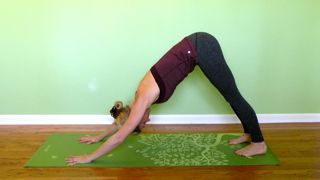19 Jan Q&A
Q: Do I engage the muscles in my thighs and lift my kneecaps when I’m in Downward Facing Dog?
A: In my experience, it is always easier to remember the answer to a question about how to practice a certain yoga pose, when you understand the mechanics of the posture. In this case, Downward Facing Dog (Adho Mukha Svanasana). Downward Facing Dog is an interesting pose, as it has some traits of an Inversion (the head is below the heart), as well as of a Forward Fold (there is a certain flexion of the hips). The most important characteristic of Downward Facing Dog, is the intense stretch of the muscles and the connective tissue in the back body when practicing this pose, from the soles of the feet through the back of the legs, back and neck, over the crown of the head to the fore head.
A big set of muscles in the back of the legs is the hamstrings. When reaching the heels down towards the floor and lifting the Sitz bones high up towards the sky, the hamstrings need to lengthen. In order for the hamstrings to lengthen, they need to relax. And for the hamstrings to relax, the antagonistic muscles need to contract. The muscles that “belong” to the hamstrings, making a pair that works together, are the quadriceps (the muscles in the thighs). So by contracting the quadriceps (or rather: gently engaging, by visualizing that the muscles hug the femur bone, to prevent over exertion) you will help the hamstring to lengthen and thus creating a safe and meaningful stretch of the back of the legs. The gentle lifting of the kneecaps goes hand in hand with the engagement of the quadriceps.
When you are practicing Downward Facing Dog, you can experiment by engaging the quadriceps and then relaxing them, to feel the difference in the stretch of the back body.
